
- DIGITAL MAGAZINE

MOST POPULAR
Facts about Mars
How much do you know about the red planet.
Calling all budding young space cadets! Join us on an out-of-this-world adventure with our fascinating facts about Mars…
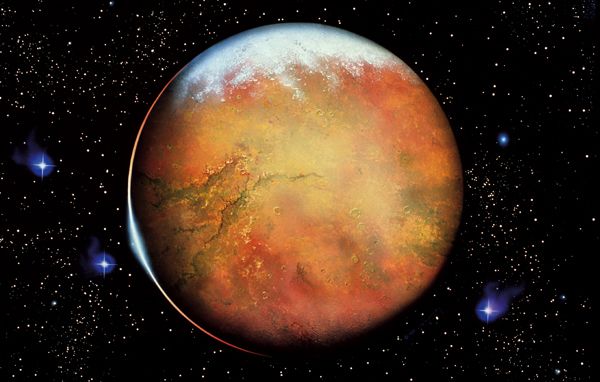
1) Named after the Roman God of war , Mars is the fourth planet from the sun in our solar system .
2) Mars is also known as the ‘ Red Planet ’ because, well, it’s red! This signature colour comes from the large amount of a chemical called iron oxide (or ‘rust’ as you might know it) in its rocks and soil.

3) Mars is the second smallest planet in the solar system after Mercury . With a diameter (distance through the middle) of 6,791 kilometres , it’s roughly half the size of Earth .
4) It can get pretty cold on Mars –– much colder than our own planet , since it’s further away from the sun. At the equator, temperatures can reach 20°C , but at its poles they can plummet to as low as -140°C . Brr !
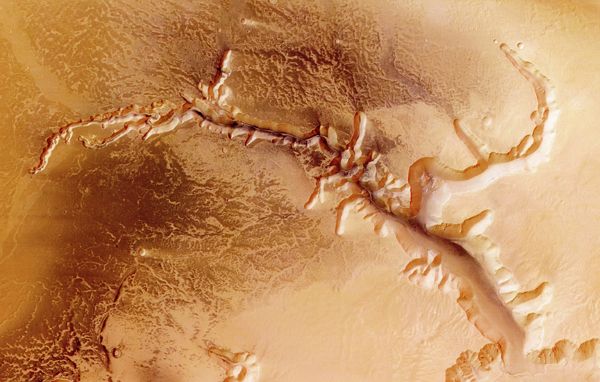
5) Mars is home to the highest mountain in our solar system –– a volcano called Olympus Mons . Standing a whopping 24 kilometres high , it’s about three times the height of Mount Everest!
Did you know…? There are bits of Mars here on Earth! In the past, asteroids hit the Red Planet, sending debris into space. Some of this debris landed on our planet as meteorites.
6) You could jump around three times higher on Mars than you can on Earth. Boing ! This is because the planet’s gravity – the force that keeps us on the ground – is much weaker.

7) Do you like to look at the moon at night? Well, check this out –– Mars has two moons ! One is called Phobos and the other Deimos .
8) A day on Mars is 24 hours and 37 minutes –– only a little bit longer than a day on our own planet. A year on Mars, however, is almost twice as long, lasting 687 Earth days ! This is because it takes a lot longer than Earth to complete its orbit around the Sun.
Did you know that we have a FREE downloadable Mars primary resource ? Great for teachers, homeschoolers and parents alike!
9) Until recently, scientists believed that there was no liquid water on the surface of Mars –– only rocks, soil dust and ice. But… News flash! In 2018, they found evidence of a lake under the planet’s south polar ice cap. Exciting stuff!
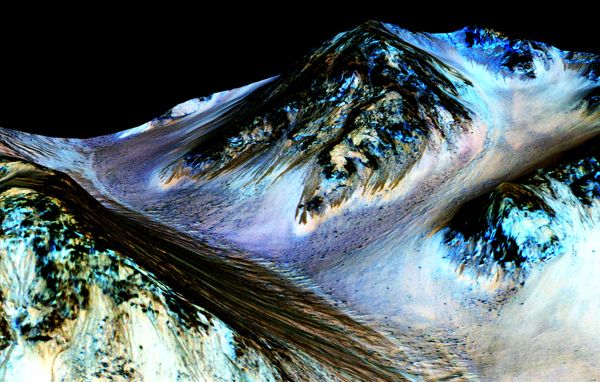
10) Humans have not yet been to Mars, but scientists have sent spacecraft there to help them research this fascinating planet. The first spacecraft to land on Mars were the Viking Landers , which touched down on the surface in 1976 .
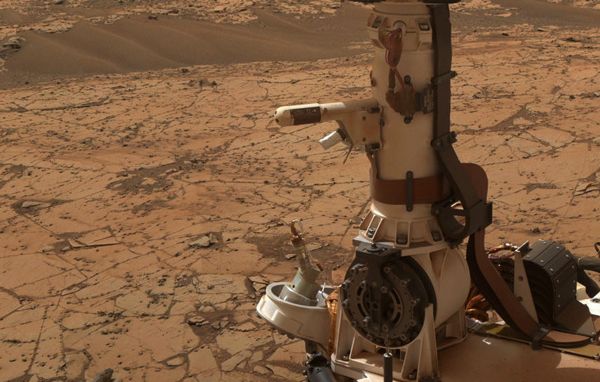
Want to learn more? Check out our facts about Earth , discover top Moon facts and learn about world-famous astronaut Neil Armstrong .
What did you think of our facts about Mars? Leave a comment below and let us know!
Leave a comment.
Your comment will be checked and approved shortly.
WELL DONE, YOUR COMMENT HAS BEEN ADDED!
I'm doing a project and it really helps
this is for school and its helping me lot!
I love Mars so much
this website is amazing good gob keep up the work.
I love Mars!
I have never been on mars
THANK YOU! HELPS SOOOOO MUCH!
this is amazing
this helped a lot with my presentation
This helped me a lot!
This is just AWESOME!
WOW!!!!!!!!!!!!!!!!!!!!!!!!!!!!!!!!!!!!!!!!!!!!
this is so cool
this was very usefull
These facts really helped me for my school work
hi this is an amazing website
These facts were useful for my space project. I chose to do it about Mars!
Great you helped me do my homework!!
ive got really great infomation of this
good to know
lets take action
Educational
Interesting
thank you this was amazing
That's so cool
the facts are amaizing
super awesome
this is really helpful!!
Woooooooooooooooooooooooooooooooooooooooooooooooooooooooooooooooooooooooooooooooooooooooooooooooooooooooooow
I'm a girrafe
... [Trackback] [...] Informations on that Topic: natgeokids.com/uk/discover/science/space/facts-about-mars/ [...]
Not bad not bad
Cool it teach us a lot of astronomy about mars
great site, loved the facts, recommend it
could youse more facts
Best avatar
thanks for the wonderful info
I love mars
Mars is so cool!
love it thankyou
i like this
Never realised Mars is smaller than earth. I thought it was just smaller than Jupiter
what is so cool about MARS lol .
So interesting!!
CUSTOMIZE YOUR AVATAR
More like space.

Universe Facts

Neil Armstrong facts!

Space Junk!

The Phases of the Moon

Sign up to our newsletter
Get uplifting news, exclusive offers, inspiring stories and activities to help you and your family explore and learn delivered straight to your inbox.
You will receive our UK newsletter. Change region
WHERE DO YOU LIVE?
COUNTRY * Australia Ireland New Zealand United Kingdom Other
By entering your email address you agree to our Terms of Use and Privacy Policy and will receive emails from us about news, offers, activities and partner offers.
You're all signed up! Back to subscription site
Type whatever you want to search
More Results

You’re leaving natgeokids.com to visit another website!
Ask a parent or guardian to check it out first and remember to stay safe online.

You're leaving our kids' pages to visit a page for grown-ups!
Be sure to check if your parent or guardian is okay with this first.
Mars is the fourth planet from the Sun – a dusty, cold, desert world with a very thin atmosphere. Mars is also a dynamic planet with seasons, polar ice caps, canyons, extinct volcanoes, and evidence that it was even more active in the past.
Mars is one of the most explored bodies in our solar system, and it's the only planet where we've sent rovers to roam the alien landscape.
NASA currently has two rovers ( Curiosity and Perseverance ), one lander ( InSight ), and one helicopter ( Ingenuity ) exploring the surface of Mars.
Perseverance rover – the largest, most advanced rover NASA has sent to another world – touched down on Mars on Feb. 18, 2021, after a 203-day journey traversing 293 million miles (472 million kilometers). The Ingenuity helicopter rode to Mars attached to the belly of Perseverance.
Perseverance is one of three spacecraft that arrived at Mars in 2021. The Hope orbiter from the United Arab Emirates arrived on Feb. 9, 2021. China’s Tianwen-1 mission arrived on Feb. 10, 2021, and includes an orbiter, a lander, and a rover. Europe and India also have spacecraft studying Mars from orbit.
In May 2021, China became the second nation to ever land successfully on Mars when its Zhurong Mars rover touched down.
An international fleet of eight orbiters is studying the Red Planet from above including three NASA orbiters: 2001 Mars Odyssey , Mars Reconnaissance Orbiter , and MAVEN .
These robotic explorers have found lots of evidence that Mars was much wetter and warmer, with a thicker atmosphere, billions of years ago.
Pop Culture
No other planet has captured our collective imagination quite like Mars.
In the late 1800s when people first observed the canal-like features on Mars' surface, many speculated that an intelligent alien species resided there. This led to numerous stories about Martians, some of whom invade Earth, like in the 1938 radio drama, "The War of the Worlds ." According to an enduring urban legend, many listeners believed the story to be real news coverage of an invasion, causing widespread panic.
Countless stories since have taken place on Mars or explored the possibilities of its Martian inhabitants. Movies like "Total Recall" (1990 and 2012) take us to a terraformed Mars and a struggling colony running out of air. A Martian colony and Earth have a prickly relationship in "The Expanse " television series and novels.
And in the 2014 novel and its 2015 movie adaptation, "The Martian," botanist Mark Watney is stranded alone on the planet and struggles to survive until a rescue mission can retrieve him.
- NASA’s Mars Exploration Program
- NASA: Moon to Mars
- For Kids: About Mars

All About Mars

Mars’ atmosphere has clouds and wind just like Earth. Sometimes the wind blows the red dust into a dust storm. Spiraling dust storms–called dust devils–can look like tornadoes. Mars’ large storms sometimes cover the entire planet. Credit: NASA/JPL-Caltech
Mars is a cold desert world. The average temperature on Mars is minus 85 degrees Fahrenheit – way below freezing. It is half the size of Earth. Mars is sometimes called the Red Planet. It's red because of rusty iron in the ground.
Like Earth, Mars has seasons, polar ice caps, volcanoes, canyons, and weather. It has a very thin atmosphere made mostly of carbon dioxide, nitrogen, and argon. People would not be able to breathe the air on Mars.
Explore Mars! Click and drag to rotate the planet. Scroll or pinch to zoom in and out. Credit: NASA Visualization Technology Applications and Development (VTAD)
There are signs of ancient floods on Mars, but now water mostly exists in icy dirt and thin clouds. On some Martian hillsides, there is evidence of liquid salty water in the ground.
Scientists want to know if Mars may have had living things in the past. They also want to know if Mars could support life now or in the future.

Credit: NASA/JPL-Caltech
Structure and Surface
- Mars is a terrestrial planet. It is small and rocky.
- Mars has a thin atmosphere.
- Mars has an active atmosphere, but the surface of the planet is not active. Its volcanoes are dead.
Time on Mars
- One day on Mars lasts 24.6 hours. It is just a little longer than a day on Earth.
- One year on Mars is 687 Earth days. It is almost twice as long as one year on Earth.
Mars’ Neighbors
- Mars has two moons. Their names are Phobos and Deimos.
- Mars is the fourth planet from the Sun. That means Earth and Jupiter are Mars’ neighboring planets.
Quick History
- Mars has been known since ancient times because it can be seen without advanced telescopes.
- There was even a flying helicopter on Mars. Seriously! The Mars Helicopter, Ingenuity , successfully tested powered, controlled flight on another world for the first time. It hitched a ride to Mars on the Perseverance rover and worked with the rover to explore Mars. Ingenuity was designed as a tech demo expected to fly no more than five times over 30 days. It ended its mission in early 2024 having completed 72 flights in just under three years. Thanks Ingenuity!
- Several missions have orbited, landed on, or roved around on Mars: InSight , MAVEN , Mars Reconnaissance Orbiter , and many more ! Mars is the only planet we have sent rovers to. They drive around Mars, taking pictures and measurements. Learn more about them and what they have discovered by clicking the pictures below!
Mars Rovers
Perseverance
Spirit and Opportunity
What does Mars look like?

This infographic uses composite orbiter images and an outline of the United States to show the scale of the Valles Marineris (a canyon system more than 2,000 miles long!). Swipe left and right to see how big this canyon system is compared to the United States. Credit: NASA/JPL-Caltech
This animated GIF was created using footage taken by NASA’s Ingenuity Mars Helicopter during its 25th flight on April 8, 2022. Credit: NASA/JPL-Caltech
This animated image blinks two versions of a May 11, 2016, selfie of NASA's Curiosity Mars rover at a drilled sample site called "Okoruso." In one version, cameras atop the rover's mast face the arm-mounted camera taking the portrait. In the other, they face away. Credit: NASA/JPL-Caltech/MSSS

NASA's Curiosity Mars rover used its black-and-white navigation cameras to capture panoramas at two times of day on April 8, 2023. Credit: NASA/JPL-Caltech
Explore Mars!
Mars Activities
Make a Mask
Coloring Pages
Scavenger Hunt
For more information visit:
NASA's Mars Exploration Program
Planet Mars Overview
Explore with Perseverance!
Explore the Solar System

If you liked this, you may like:
7 Things to Know About the Mars 2020 Perseverance Rover Mission

This illustration depicts NASA's Perseverance rover operating on the surface of Mars. Perseverance will land at the Red Planet's Jezero Crater a little after 3:40 p.m. EST (12:40 p.m. PST) on Feb. 18, 2021. For more information about the mission, go to https://mars.nasa.gov/mars2020/
NASA's next rover to the Red Planet launched on July 30 and will land on Feb. 18, 2021. These highlights will get you up to speed on the ambitious mission.
In less than a month, NASA expects to launch the Mars 2020 Perseverance mission from Cape Canaveral, Florida. Loaded with scientific instruments, advanced computational capabilities for landing, and other new systems, the Perseverance rover is the largest, heaviest, most sophisticated vehicle NASA has ever sent to the Red Planet.
"Perseverance sets a new bar for our ambitions at Mars," said Lori Glaze, planetary science director at NASA Headquarters in Washington. "We will get closer than ever before to answering some of science's longest-standing questions about the Red Planet, including whether life ever arose there."
Get the Latest JPL News
What drives Perseverance's mission and what will it do at the Red Planet? Here are seven things to know:
1. The Perseverance rover draws on the NASA - and scientific - spirit of overcoming challenges.
The rover has a tough mission. Not only does it have to land on a treacherous planet, it has to work on its science goals: searching for signs of ancient microbial life, characterizing the planet's geology and climate, collecting carefully selected rock and sediment samples for future return to Earth, and paving the way for human exploration beyond the Moon.
These activities epitomize why NASA chose the name Perseverance from among the 28,000 essays submitted during the "Name the Rover" contest. Because of the coronavirus pandemic, the months leading up to the launch in particular have required creative problem solving , teamwork, and determination.
"Building this incredibly sophisticated rover has been the hardest thing I've ever been a part of as an engineer," said Ray Baker, the mission's flight system manager at NASA's Jet Propulsion Laboratory in Southern California. "While coronavirus added significant challenges and logistics, the team has shown great determination and diligence to build a rover we can be proud to send to Mars. We can't wait to see the many years of dedication pay off at the launch pad."
2. Perseverance builds on the lessons of other Mars rovers.
NASA's modest first rover - Sojourner - demonstrated in 1997 that a robot could rove on the Red Planet. Spirit and Opportunity, which landed in 2004, found evidence that the planet once hosted running water before becoming a frozen desert. Curiosity, which has been exploring Mars since 2012, discovered that its landing site, Gale Crater, was home to of a lake billions of years ago, with an environment that could have supported microbial life .
Perseverance aims to take the next step, seeking, as a primary goal, to answer one of the key questions of astrobiology : Are there any signs that life once existed on Mars?
3. The rover will be landing in a place with high potential for finding signs of past microbial life.
Jezero Crater is 28 miles (45 kilometers) wide and sits on the western edge of Isidis Planitia, a giant basin just north of the Martian equator dug out long ago when a space rock hit the surface. Sometime between 3 billion and 4 billion years ago at Jezero, a river flowed into a body of water the size of Lake Tahoe.
"The science team has had many discussions internally and externally about where the next Mars rover should go," said Ken Farley, the mission's project scientist, based at Caltech in Pasadena. "We ultimately chose Jezero Crater because it is such a promising location for finding organic molecules and other potential signs of microbial life."
4. Perseverance will also be collecting important data about Mars' geology and climate.
Mars orbiters have been collecting images and other data from Jezero Crater from about 200 miles (322 kilometers) above, but finding signs of ancient life on the surface will require much closer inspection. It demands a rover like Perseverance, which can look for signs that may be related to life and can analyze the context in which they were found to see if they were biological in origin.
Understanding Mars' past climate conditions and reading the geological history embedded in its rocks will also give us a sense of why Earth and Mars - which formed from the same primordial stuff - ended up so different.
5. Perseverance is the first leg of a round trip to Mars.
Verifying ancient microscopic life on Mars carries an enormous burden of proof. Perseverance is the first rover to bring a sample-gathering system to Mars that will package promising examples of rocks and sediments for return to Earth by a future mission.
A Mars Sample Return campaign is being planned by NASA and the European Space Agency because here on Earth we can investigate the samples with instruments too large and complex to send to Mars. Terrestrial laboratories would be used to establish whether any potential signs of life detected by the rover are definitive evidence of past life.
6. Perseverance carries instruments and technology that will pave the way for human missions to the Moon and Mars.
The Terrain-Relative Navigation system, which autonomously helps the rover avoid hazards during landing, and the Mars Science Laboratory Entry, Descent, and Landing Instrumentation 2 ( MEDLI2 ) sensor suite, which gathers crucial data during the journey through the Martian atmosphere, will help future human missions land more safely and with larger payloads on other worlds.
Perseverance also has features that will help astronauts once they're on the surface of another world: improved self-driving smarts for more efficient travel and the Mars Environmental Dynamics Analyzer ( MEDA ) instrument suite, which will provide key information about weather, climate, and dust. Meanwhile, the Mars Oxygen In-Situ Resource Utilization Experiment ( MOXIE ) technology demonstration aims to produce oxygen from Mars' carbon dioxide atmosphere, demonstrating a way future explorers might produce oxygen for rocket propellant as well as for breathing.
7. You will get to ride along.
The Perseverance rover and other parts of the Mars 2020 spacecraft feature 23 cameras - more cameras than any interplanetary mission in history. They'll help engineers put together a high-definition view of the landing process after the rover safely touches down on Mars on Feb. 18, 2021, and they'll deliver images of the landscape and scientific specimens in breathtaking detail. And as with previous Mars missions, this one plans to make raw and processed images available on the mission's website .
Perseverance also carries three silicon chips with the names of nearly 11 million people who signed up to ride with the mission.
You can follow Perseverance's adventure on social media @NASAPersevere and @NASAMars.
For more highlights and other details about the launch, check out the mission's press kit:
https://go.nasa.gov/perseverance-launch-press-kit
For more on the mission, visit:
https://mars.nasa.gov/perseverance/
For more about NASA's Moon to Mars plans, visit:
https://www.nasa.gov/topics/moon-to-mars
News Media Contact
Jia-Rui Cook
Jet Propulsion Laboratory, Pasadena, Calif.
818-354-0724
Grey Hautaluoma / Alana Johnson
NASA Headquarters, Washington
202-358-0668 / 202-358-1501
[email protected] / [email protected]

- PHOTO GALLERY
4 Years on Mars: Curiosity's Incredible Journey in Pictures
Four years after its harrowing descent through Mars's thin atmosphere, Curiosity celebrates its action-packed journey.
Four Earth-years ago today, NASA’s Curiosity rover successfully touched ground on Mars's dusty surface, after surviving a nail-biting descent through the red planet's thin atmosphere.
Since its triumphant arrival, the car-size "laboratory on wheels" has traveled more than 8.4 miles (13.5 kilometers), taking pictures, collecting samples, and analyzing rocks along the way. Recent software upgrades even let Curiosity autonomously choose which rocks it examines— and shoots with laser beams .
Curiosity has spent more than 1,421 sols, or Martian days, exploring Gale Crater , a low-lying region that may have held past life, if it existed. While the rover has yet to confirm whether Mars once hosted living things, it has found evidence of an ancient freshwater lake in the sediments of Yellowknife Bay, the lowest point of the crater, offering tantalizing insight into the planet's past habitability.
Since September 2014, Curiosity has been examining Mount Sharp, a mountain of layered rocks towering more than three miles (five kilometers) high in the middle of Gale Crater.
These layers likely "captured a long record of time, just like the layers in the Grand Canyon," said Ashwin Vasavada, Curiosity's deputy project scientist, in a previous interview .
Beyond examining rocks, Curiosity has a suite of weather instruments that has been providing scientists with crucial information about the planet. For instance, researchers are tracking changes in methane in the Martian atmosphere, which fluctuates by up to a factor of 10 for unknown reasons. The rover also monitors the peculiar flow of winds inside the large basin of Gale Crater, and it keeps tabs on radiation exposure on Mars, which may affect future human missions to the red planet.
Even after four years— and a recent software scare —the rover is healthy and has a lot of life in it. Speaking from the rover's perspective a year ago, "we don't feel like we are getting old yet," said Vasavada. "We still feel like we have a lot ahead of us."
Maya Wei-Hass contributed reporting.
Follow Michael Greshko on Twitter .
FREE BONUS ISSUE
Related topics.
- EXPLORATION
You May Also Like

Why signs of life on Mars remain so mysterious
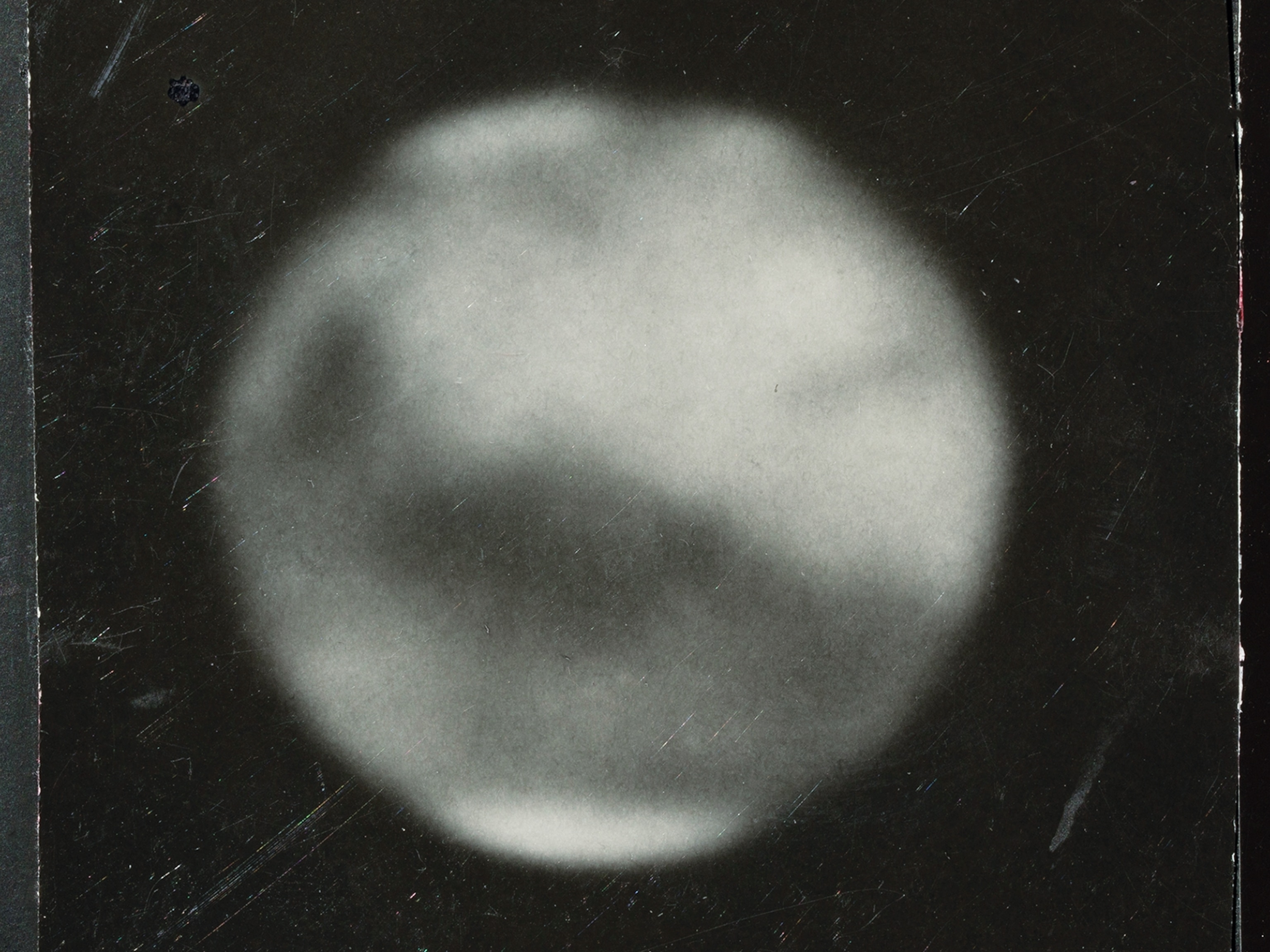
Why are people so dang obsessed with Mars?

See how people have imagined life on Mars through history

A raging river and frost-tipped dunes reveal watery history on Mars

How helicopters are shaking up the hunt for life on Mars
- Environment
- Perpetual Planet
- History & Culture
History & Culture
- History Magazine
- Mind, Body, Wonder
- Terms of Use
- Privacy Policy
- Your US State Privacy Rights
- Children's Online Privacy Policy
- Interest-Based Ads
- About Nielsen Measurement
- Do Not Sell or Share My Personal Information
- Nat Geo Home
- Attend a Live Event
- Book a Trip
- Inspire Your Kids
- Shop Nat Geo
- Visit the D.C. Museum
- Learn About Our Impact
- Support Our Mission
- Advertise With Us
- Customer Service
- Renew Subscription
- Manage Your Subscription
- Work at Nat Geo
- Sign Up for Our Newsletters
- Contribute to Protect the Planet
Copyright © 1996-2015 National Geographic Society Copyright © 2015-2024 National Geographic Partners, LLC. All rights reserved
Mars: The Red Planet
Mars is the fourth planet from the sun.

- How did it get its name?
- What is it made of?
- How far is it from the sun?
- How many moons does it have?
- How have humans explored it?
- Is there life?
- Is there water?
Additional resources
Mars, the fourth planet from the sun, is a dry, rocky world whose iconic red color has earned it the nickname the Red Planet. Mars has fascinated people throughout history, and today, it is one of the most explored bodies in the solar system , with many rovers and orbiters searching the planet for evidence of life, past or present.
How did Mars get its name?
Because Mars is visible with the naked eye in Earth 's night sky, many ancient civilizations noticed and named it. The ancient Romans named the planet Mars after the Roman god of war, according to NASA , because they associated the planet's blood-red color with conflict and battles.
Similarly, the Babylonians called the Red Planet Nergal, after their god of fire, war and destruction; and early Hindus named it Mangala, after their own god of war, according to a website run by the U.K. National Astronomy Week . The ancient Egyptians called it Her Desher, meaning "the red one," according to NASA.
What is Mars made of?
The Red Planet is rocky, much like Earth. It has a diameter of roughly 4,222 miles (6,794 kilometers) — about half of Earth's diameter, according to the European Space Agency ( ESA ).
Mars' crust is 6 to 30 miles (10 to 50 km) thick and is composed mainly of iron, magnesium, aluminum, calcium and potassium, according to NASA. Below that is a rocky mantle 770 to 1,170 miles (1,240 to 1,880 km) thick, which surrounds a dense core that's made of iron, nickel and sulfur and has a radius of 930 to 1,300 miles (1,500 to 2,100 km).
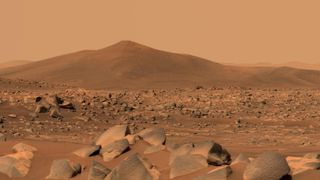
Scientists used NASA's Insight lander, which picked up seismic vibrations on the planet, to map Mars' insides in detail . They found that the planet's core was much larger than expected, taking up roughly half of Mars' interior.
Mars' rocky surface is covered in dust, boulders and numerous craters. Such features have fooled many people over the centuries, making them believe they had spotted gigantic face-like structures, tiny humanoids and even hairy blue spiders. These are all tricks of the human imagination, which is geared toward seeing recognizable things, Live Science previously reported.
A thin atmosphere surrounds the Martian surface, which has almost 1,000 times less pressure than the pressure at sea level on Earth, according to Arizona State University . Mars' atmosphere is 95% carbon dioxide, 3% nitrogen, 1.6% argon, and trace amounts of oxygen, carbon monoxide, water, methane and other gases, as well as dust. The light dust is easily blown around the planet by winds, giving the skies a tan color. A probe built by the United Arab Emirates recorded beautiful and enormous auroras wrapping halfway around Mars in 2022.
How far is Mars from the sun?
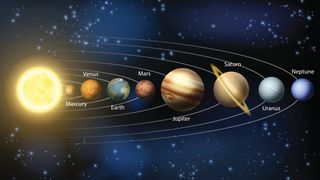
Mars orbits at an average distance of 142 million miles (228 million km) from the sun , according to NASA . Its orbit is about 1.5 times the size of Earth's. Sunlight takes roughly 13 minutes to get to Mars, while it takes around 8 minutes to reach our planet.
A day on Mars lasts about 24.6 hours, or just a little longer than a day on Earth. Martian days are called sols — short for solar day — and there are 669.6 sols in a Martian year. Mars' axial tilt is also very similar to our planet's, at about 25 degrees (Earth's is 23.4 degrees), meaning Mars experiences seasons much like those on Earth.
How many moons does Mars have?
Mars has two small, potato-shaped moons named Phobos and Deimos, according to NASA. These satellites are named for two sons of the Greek god of war Ares (Latin: Mars), according to Live Science’s sister site, Space.com . The names Phobos and Deimos mean fear and panic, respectively.

The innermost moon, Phobos, is heavily cratered and roughly 13.8 miles (22.2 km) in diameter. In about 50 million years, it is expected to break up or crash into Mars, according to NASA.
Deimos orbits 2.5 times farther from Mars than Phobos does and is half the size — about 7.8 miles (12.6 km) across — according to Cool Cosmos . Both moons are made mostly from rock and iron and may have once been asteroids that got captured by Mars' gravitational pull.
How have humans explored Mars?
The Red Planet has been a target for investigations over many centuries. No planet has been so heavily explored, other than our own, according to NASA.
Starting in the late 1700s, British astronomer William Herschel made some early scientific observations of Mars with a telescope, and he noted that Mars had darker areas, which he believed to be oceans, and lighter regions, which he thought were continents like those on Earth.
In the 19th century, Mars was investigated by Italian astronomer Giovanni Schiaparelli and American astronomer Percival Lowell, who believed they saw long canals on the planet's surface indicating civilizations and life. Their claims were dismissed by others in their time and ultimately turned out to be incorrect.
The first attempts from both the U.S. and the USSR to send probes to Mars during the space race ended in failure, according to ESA . The first probe to succeed was NASA's Mariner 4 probe, which reached the Red Planet on July 15, 1965, flying by it and sending back photos of the planet's surface, according to NASA . While the U.S. managed a few more early triumphs, the Soviet Union's probes mainly failed. Historically, half of all the probes sent to Mars have crashed or died.
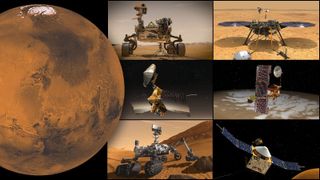
NASA's Mariner 9 was the first mission to successfully orbit Mars, according to the agency. Reaching its target in 1971, Mariner 9 studied a large dust storm that engulfed most of the planet. The Viking 1 and 2 landers were the first human-made objects to make it to the Red Planet's surface and survive for more than a few minutes, when they reached the Martian land in 1976, according to The Planetary Society . From the surface, they proceeded to take photos and data readings of their surroundings, as well as conduct the first search for life on the planet.
Though there was a lull in missions afterward, space agencies around the world continued to make attempts at robotic exploration of Mars during the 1980s and 1990s. On July 4, 1997, NASA landed its first probe on Mars in two decades — the Pathfinder lander and its adorable tiny rover, Sojourner, according to The Planetary Society . These were followed by many orbiters and landers, including the twin rovers Opportunity and Spirit, which conducted investigations from 2004 to 2018 and 2019, respectively.
The current suite of robots on Mars includes NASA's Curiosity and Perseverance rovers, both of which have produced incredible scientific findings during their missions. Perseverance carried Ingenuity, the first helicopter to fly on Mars, and it has produced stunning images during its travels. China 's Zhurong rover, part of the country's Tianwen-1 mission, successfully landed on Mars in 2021, and it has sent back beautiful pictures and even sounds from the surface .
Many other missions, both past and present, have produced amazing insights about the planet's history, and future planned missions should help continue this progress, according to The Planetary Society . NASA aims to send humans to explore the Red Planet by the late 2030s or early 2040s, according to Space.com .
Is there life on Mars?
NASA scientists believe that life may have once thrived on Mars, as there is ample evidence that the planet used to be much warmer and wetter billions of years ago. Whether there is anything alive today on Mars is an open question.
NASA's Curiosity rover detected methane — a potential indicator of microbial activity — expelled from the ground in the region known as Gale Crater. The probe also spotted intriguing evidence of organic compounds in the Martian soil, though what that means isn't entirely clear.
Is there water on Mars?
The possibility that there were once oceans and rivers on Mars is fairly well established. Observations suggest that there could have been water on the surface as recently as 2 billion years ago .
Nobody knows if much water is still there today. Some probes have spotted signs of dark streaks that appear to flow downhill , but it's still unclear what, exactly, these observations represent. In 2020, scientists thought they spotted evidence of buried lakes of liquid water beneath Mars' south polar ice cap, but later data suggested that these were merely clay deposits that produced bright radar reflections mimicking bodies of water.
- See how NASA is currently exploring Mars, as well as the agency's plans for Mars exploration, on this website dedicated to Martian probes.
- Dive into this stunning map of different regions on the Red Planet, courtesy of the U.S. Geological Survey.
- Browse even more amazing images from NASA's Mars missions on the agency's multimedia page.
Sign up for the Live Science daily newsletter now
Get the world’s most fascinating discoveries delivered straight to your inbox.

Adam Mann is a freelance journalist with over a decade of experience, specializing in astronomy and physics stories. He has a bachelor's degree in astrophysics from UC Berkeley. His work has appeared in the New Yorker, New York Times, National Geographic, Wall Street Journal, Wired, Nature, Science, and many other places. He lives in Oakland, California, where he enjoys riding his bike.
NASA Mars samples, which could contain evidence of life, will not return to Earth as initially planned
Single enormous object left 2 billion craters on Mars, scientists discover
Ancient, 30-foot ancestor of great white shark unearthed in Mexico quarry
Most Popular
- 2 What's the largest waterfall in the world?
- 3 Global 'time signals' subtly shifted as the total solar eclipse reshaped Earth's upper atmosphere, new data shows
- 4 'Uncharted territory': El Niño to flip to La Niña in what could be the hottest year on record
- 5 Rare 'porcelain gallbladder' found in 100-year-old unmarked grave at Mississippi mental asylum cemetery
- 2 'I nearly fell out of my chair': 1,800-year-old mini portrait of Alexander the Great found in a field in Denmark
- 3 NASA reveals 'glass-smooth lake of cooling lava' on surface of Jupiter's moon Io
- 4 'We were in disbelief': Antarctica is behaving in a way we've never seen before. Can it recover?
- 5 Hundreds of emperor penguin chicks spotted plunging off a 50-foot cliff in 1st-of-its-kind footage

Mars Quick Facts
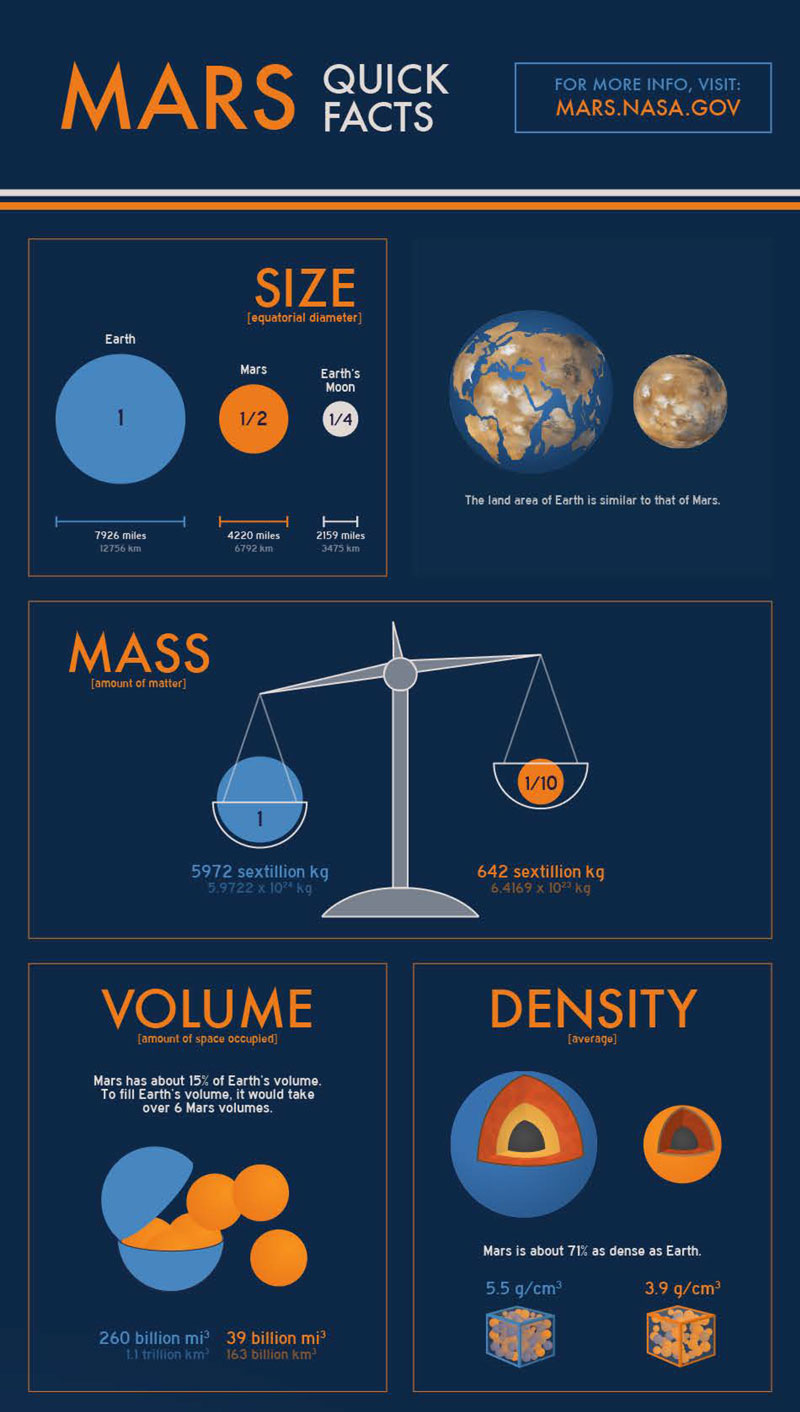
Download this infographic about quick facts of Mars compared to Earth.
- Size (equatorial diameter)
- Mass (amount of matter)
- Volume (amount of space occupied)
- Density (average)
- Planet Structure
- Distance (average distance from orbit path to the Sun)
- Speed (velocity relative to the Sun)
- Tilt / Seasons
- Atmosphere (characteristics and approximate composition)
- Temperature (approximate average and high/low ranges)
- Weight (effect of gravity on matter)
Read more about Mars here:
https://mars.nasa.gov/all-about-mars/facts/
(pdf?emrc=662b7e981bd14) (337.74 KB)
Mars: Facts About the Red Planet

The red planet Mars has been known to humans since ancient times. It has been the target of dozens of space missions and will hopefully soon become the first planet astronauts will land on. In this article, we’ll tell you everything you need to know about Mars and answer the most common questions related to the Red Planet. Let’s get started!

Is Mars bigger than the Earth?
How long is a year on mars, how long is a day on mars, does mars have seasons, how far is mars from the sun, how far is mars from the earth, how long does it take to get to mars, missions to mars, how was mars formed, mars structure, mars surface, mars atmosphere, how many moons does mars have, april 29: mars-neptune, may 5: mars next to the moon; lunar occultation of mars, july 15: mars-uranus, august 14: mars-jupiter, what is the gravity on mars, what color is mars, what is the temperature on mars, how many rovers are on mars, fun facts about mars.
- Planet type : terrestrial
- Radius : 3,396 km
- Mass : 6.417 × 10^23 kg
- Aphelion : 249.2 million km (154.9 million miles)
- Perihelion : 206.6 million km (128.4 million miles)
- Average distance from the Earth : 225 million km (140 million miles)
- Surface temperature : −143 °C to 35 °C (-226 °F to 95 °F)
- Solar day length : 24 h 39 m 35 s
- Sidereal day length : 24 h 37 m 22 s
- Year length : 686.98 Earth days
- Age : 4.503 billion years
- Named after : Roman god of war
How big is Mars?
Mars is the second smallest planet in the Solar System – only Mercury is smaller. Let’s measure this planet and compare it to the Earth.
Mars has a diameter of 6,792 km (4,220 miles); the planet’s circumference around the equator is 21,326 km (13,300 miles). Thus, if you’re moving at a speed of about 100 km per hour (62 miles per hour), it will take you about nine days to travel around the planet's equator.
No, it’s not. The diameter of Mars is only about half of the Earth’s diameter, which is 12,742 km (7,917 miles). Also, Mars is only about two times bigger than our Moon, which is 3,474 km (2,158 miles) in diameter.
Mars orbital period and rotation period
Every planet in the Solar System has its own orbital period (that determines the length of year) and rotation period (that determines the length of a day-night cycle). Let’s take a look at how fast Mars revolves around the Sun and spins on its axis.
As Mars is located farther away from the Sun than the Earth, it takes longer for the Red Planet to complete one orbit around the Sun. A year on Mars lasts for about 687 Earth days , which equals 1.88 Earth years.
Mars rotates on its axis at almost the same speed as the Earth. For this reason, daily cycles on these two planets are quite similar. One Martian day (called a sol) lasts 24 hours 39 minutes , which is only 39 minutes longer than a day on the Earth.
As you probably know, seasons are caused by the tilt of a planet’s axis of rotation. Mars’ axial tilt is very similar to the Earth’s: the Red Planet is tilted at 25.2°, while the Earth's axial tilt is about 23.5°. For this reason, Mars has four distinct seasons: spring, summer, fall, and winter . However, each season on Mars lasts about two times longer than on the Earth. That’s because it takes almost two Earth years for Mars to travel around the Sun once.
How far away is Mars?
Mars is the fourth planet from the Sun and one of the Earth’s two closest neighbors (the other one being Venus).
Due to the high eccentricity of the Red Planet’s orbit, there’s a significant difference between Mars’ closest and farthest points from the Sun, which equal 206.6 million km (128.4 million miles) and 249.2 million km (154.9 million miles), respectively. On average, Mars is positioned 228 million km (142 million miles) away from our star, which equals 1.5 astronomical units.
The distance between Mars and our planet is constantly changing. The farthest distance between Mars and the Earth equals 401 million km (249 million miles). The closest distance the two planets can get to each other is 54.6 million km (33.9 million miles). However, such a close approach never happened in recorded history. The closest approach between Mars and the Earth in almost 60,000 years occurred in 2003 when the two celestial bodies were 55.7 million km (34.6 million miles) away from each other.
The duration of a trip to Mars depends on when it is taken. The best time to launch a spaceship to Mars is about three months before the Red Planet gets closest to the Earth. Such a moment happens about every two years, around Mars’ opposition. According to NASA , an average trip to Mars takes about nine months .
The two fastest trips to Mars were taken by Mariner 6 (five months) and Mariner 7 (four months). However, these two spacecraft performed flybys of Mars and so didn’t need to slow down as orbiters, landers, and rovers do. The latest rover to land on Mars – Perseverance – reached the planet in about seven months .
As the Earth’s close neighbor, Mars has been the destination of numerous space missions. Since 1960, about 50 missions have been sent to the Red Planet, though only about half of them have been successful. Let’s take a look at the most significant ones.
NASA’s Mariner 9 entered Mars’ orbit in 1971, becoming the first spacecraft to orbit another planet. Mariner 9 mapped 85% of the Martian surface and sent more than 7,000 images back to the Earth.
The first human-made object to reach the Martian surface was the Soviet Union’s Mars 2 , launched the same year as Mariner 9. Unfortunately, the speed at which Mars 2 approached the planet was too high; as a result, the descent system malfunctioned, and the spacecraft crashed into the Red Planet’s surface.
The first spacecraft to successfully land on Mars was NASA’s Viking 1 . This spacecraft operated on the planet from 1976 to 1982 and sent back more than 57,000 images.
NASA’s Sojourner , which arrived on Mars in 1997 as part of the Pathfinder mission, became the first rover to operate on another planet. The Sojourner rover operated for 83 sols, making scientific measurements and taking pictures.
NASA’s twin rovers Spirit and Opportunity reached the Red Planet in 2004. The rovers were tasked with studying the planet’s climatic history and looking for evidence of past water activity. Originally, the mission was planned to last 90 days. However, both rovers exceeded their planned mission lifetimes by many years: Spirit operated until 2010, and Opportunity stopped working only in 2018.
In 2012, NASA’s rover Curiosity arrived at the Gale crater on Mars. The rover investigated the Martian climate and geology and found out that the planet once had conditions favorable for microbial life. Curiosity has been active on Mars for more than three thousand sols; as of 2021, the rover is still operational.
In 2021, China successfully landed its first spacecraft on Mars as part of the Tianwen-1 mission. The rover named Zhurong became the first spacecraft not launched by NASA to operate on Mars.
Also in 2021, NASA’s Perseverance rover landed on the Red Planet. Apart from the rover, a helicopter called Ingenuity also takes part in the mission. On April 19, 2021, Ingenuity performed the first-ever powered, controlled flight on another planet.
What is Mars made of?
Like the other three terrestrial planets (Mercury, Venus, and the Earth), Mars is a rocky celestial body. Let’s take a closer look at the planet’s physical peculiarities.
Mars formed together with the other Solar System planets. About 4.5 billion years ago, a giant cloud of interstellar gas and dust collapsed under its own gravity and flattened into a protoplanetary disk. Mars and the other rocky planets formed in the inner part of this disk, while the gas giants settled in the outer regions of the young Solar System.
Mars has a central core, a mantle, and a crust. The Red Planet’s core is made of iron, nickel, and sulfur. It is surrounded by a rocky mantle and a crust made of iron, magnesium, aluminum, calcium, and potassium.
Mars' surface is primarily composed of basalt. The prevalence of iron oxide in the Martian soil gives the planet its distinct red color.
The Red Planet has many surface features similar to our planet: valleys, deserts, mountains, and polar ice caps. There are even former river deltas that suggest that Mars was a watery planet in the past.
The atmosphere of Mars is much thinner than the Earth’s. It is composed primarily of carbon dioxide (95%), while our planet’s atmosphere is rich in nitrogen and oxygen. Thus, humans would not be able to breathe on Mars.
However, in April 2021, NASA’s rover Perseverance successfully converted a small portion of the Martian atmosphere into oxygen . In the future, this technology might be able to provide astronauts with breathable air.
Mars has two moons: Phobos and Deimos . Both of them were discovered by American astronomer Asaph Hall in 1877. The moons of Mars are among the smallest moons in the Solar System: for reference, the Earth's Moon has a diameter more than 100 times greater than that of Phobos , the larger Martian moon. Like our Moon, Phobos and Deimos are tidally locked to their planet and always show only one side to it.
Upcoming Events
On April 29, at 04:01 GMT (12:01 a.m. ET), Mars (mag 1.1) will pass extremely close to Neptune (mag 7.9) in the constellation Pisces. The apparent distance between the planets will be only 2'14" — even the distance between Jupiter and Saturn during the Great Conjunction in 2020 was greater (6.1 arcminutes). The conjunction of Mars and Neptune will be much less spectacular, however, because Neptune is too faint to be visible to the naked eye. Grab a pair of binoculars or a telescope and look for the duo in the east in the morning. Observers in the Southern Hemisphere will have a better view.
- Occultation start: 00:05 GMT (May 4, 8:05 p.m. EDT)
- Occultation end: 04:26 GMT (00:26 a.m. EDT)
- Close approach time: 02:17 GMT (May 4, 10:17 p.m. EDT)
- Close approach distance: 0°10'
- Conjunction time: 02:26 GMT (May 4, 10:26 p.m. EDT)
- Conjunction distance: 0°12'
On May 5, the 12.4%-illuminated Moon and Mars (mag 1.2) will meet in the constellation Pisces. The planet will rise in the morning and will be visible to the naked eye. Also, a lunar occultation of Mars will be observable over South East Asia .
On July 15 at 09:22 GMT (05:22 a.m. ET), Mars (mag 0.9) will pass very close (0°33') to Uranus (mag 5.8) in the constellation Taurus. From the Northern Hemisphere, the planets will be visible high above the eastern horizon in the morning, about an hour before sunrise. From the Southern Hemisphere, they will be a little lower, in the northeastern direction. You'll need at least a pair of binoculars to see Uranus.
On August 14, at 14:45 GMT (10:45 a.m. ET), reddish Mars (mag 0.8) will pass just 0°18' from bright Jupiter (mag -2.2). This beautiful duo will be visible to the naked eye in the constellation Taurus. Considering the brightness of both planets, the distance between them, and their visibility, this conjunction can be considered the best of the year. From the Northern Hemisphere, Mars and Jupiter will be visible from about midnight until morning, rising high above the eastern horizon. In the Southern Hemisphere, the planets will rise in the northeast in the morning, a few hours before sunrise.
The gravity on Mars is 62% lower than on the Earth. This means that a person who weighs 80 kg (176 lbs) on our planet would weigh only 30 kg (66 lbs) on Mars. Although it would be much easier for humans to walk on Mars, such low gravity can have other not-so-pleasant effects on hypothetical Mars colonists – like causing muscle deterioration and osteoporosis.
The predominant color of the Martian surface is red. It is explained by the prevalence of iron oxide – more commonly known as rust – in the planet’s soil. Other colors on Mars include golden, brown, and tan.
Overall, Mars is a very cold place. The average temperature on the Red Planet equals -62 °C (-81°F). However, according to Michael Mischna , a research scientist at NASA’s Jet Propulsion Laboratory, the air temperature on Mars wouldn’t feel the same as on the Earth. There’s little water vapor and few air molecules on Mars, so -70 °C (-100 °F) would feel like -34 °C (-30 °F). To better understand temperature conditions on Mars, check this infographic made by NASA .
As of October 2021, there are six rovers on the Red Planet. Five of them (Sojourner, Spirit, Opportunity, Curiosity, and Perseverance) belong to NASA and one (Zhurong) – to China National Space Administration.
Mars can boast the largest volcano in the entire Solar System – Olympus Mons. With a height of 21 km, it stands about 2.5 times taller than Mount Everest.
Mars’ larger moon, Phobos, gradually gets closer to the planet at a rate of about 2 cm per year. In 50 million years, Phobos will either crash into Mars or disintegrate to form a ring around the Red Planet.
Billions of years ago, Mars looked very similar to the Earth. Large portions of the planet’s surface were covered with liquid water, and there may have been primitive life forms in the oceans. However, eventually, the Red Planet lost most of its atmosphere and dried up.
During the late 19th and early 20th centuries, many astronomers observed a network of canals on the Martian surface. Some believed them to be irrigation canals constructed by an alien civilization. However, it turned out to be an optical illusion.
We hope that you’ve discovered something new about the Red planet. Don’t hesitate to share this article on social media if you liked it. Also, you’re welcome to watch our educational cartoon with fun facts about Mars . We wish you clear skies and happy observations!

Mars Exploration Science Goals
The key to understanding the past, present or future potential for life on Mars can be found in NASA’s four broad, overarching goals for Mars Exploration.
Determine Whether Life Ever Arose on Mars
Conditions needed for life to thrive.
On Earth, all forms of life need water to survive. If life ever evolved on Mars, it likely did so in the presence of a long-standing water supply. That's why our search for evidence of life on Mars focuses on areas where liquid water was once stable, below the surface where it still might exist, or in current "hot spots" where hydrothermal pools (like those at Yellowstone) might be habitable. Data from multiple NASA Mars missions suggest the presence of liquid water just below the surface in rare places, and on water ice at the Martian poles. Mars missions also search for energy sources other than sunlight, since life on the Mars surface is unlikely because "superoxides" break down organic (carbon-based) molecules on which life is based. We find life on Earth in many places without sunlight--dark ocean depths, inside rocks, and deep below the surface. Chemical and geothermal energy, for example, are also energy sources for life forms on Earth. Perhaps tiny, subsurface microbes on Mars could use such energy sources, too.
Looking for Life Signs
Differentiating life from non-life is a challenge, no matter where one finds it. On Earth, we know which markers, or biosignatures, to look for, but life on another planet might be very different in chemistry, structure, and other characteristics. Life detection technologies under development will help us define life in non-Earth-centric terms, to detect it in all the forms it might take. In the meantime, NASA Mars missions look for telltale biosignatures of current and past life. Knowing the location and form on Mars of the element carbon, a fundamental building block of life, would tell us a lot about where life might have developed. The current Martian atmosphere consists mostly of carbon dioxide. Any discovery of carbonate minerals formed on the Martian surface by chemical reactions between water and the atmosphere would be a clue that water had been present for a long time--perhaps long enough for life to have developed. By studying fossils in sedimentary rock on Earth that leave a record of past life, we know that only certain environments and types of deposits preserve fossils well. We look for lakes and streams on Mars that may have left behind similar deposits.
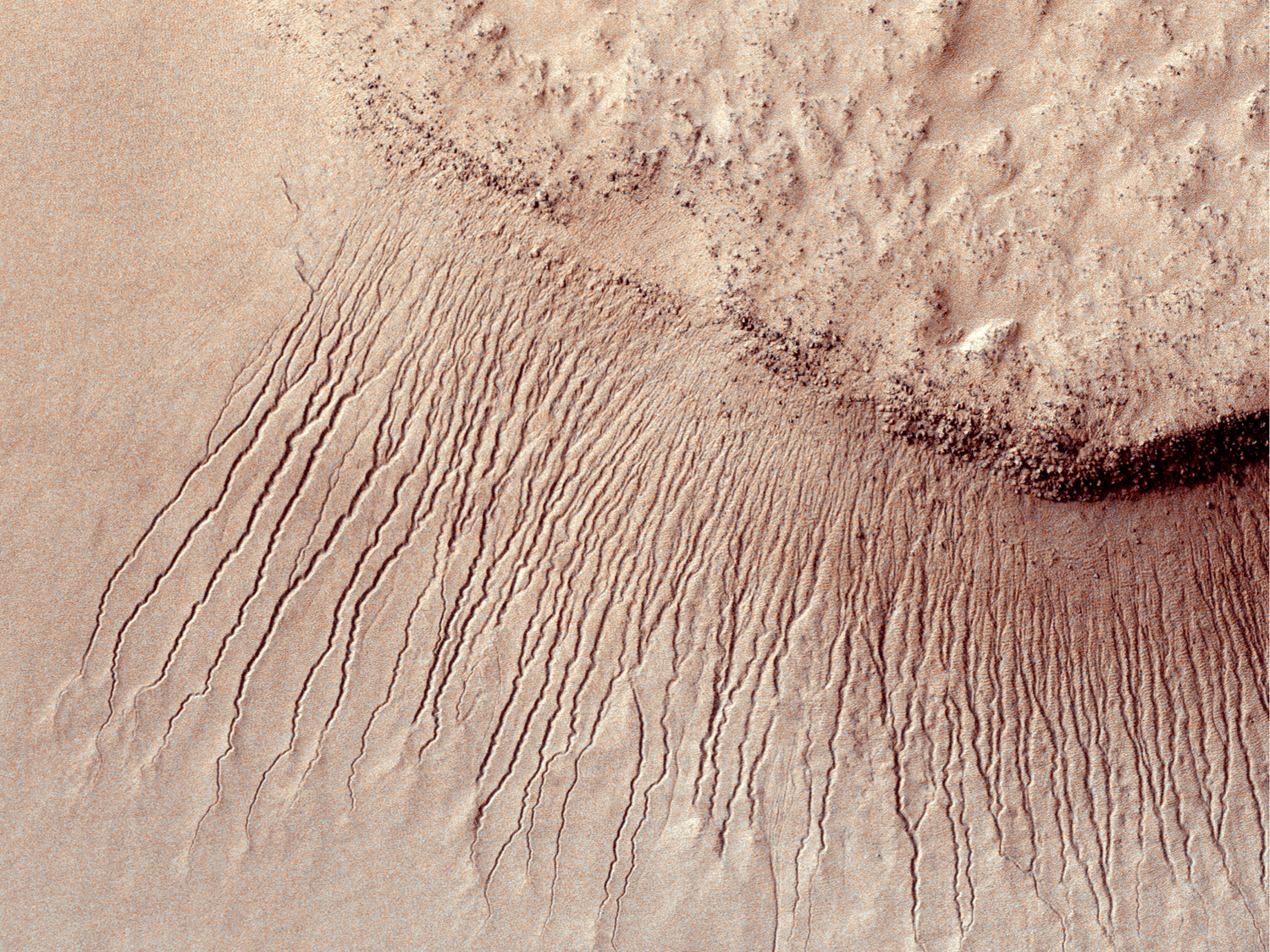
Characterize the Climate of Mars
What's the martian climate like today.
The current Martian climate is regulated by seasonal changes of carbon dioxide ice caps, atmospheric movement of large amounts of dust, and water vapor exchange between the surface and atmosphere. One of Mars' most dynamic weather patterns is the generation of dust storms, generally in the southern spring and summer. These storms can grow to encompass the whole planet. Understanding how these storms develop and grow is one science goal.

What Can the Current Climate on Mars Reveal about the Past?
A better understanding of Mars' current climate helps scientists more effectively model its past behavior. To do this, they need Mars weather maps and information about quantities of dust and water vapor in the atmosphere. Monitoring the planet for this information over one full Martian year (687 Earth days) and repeated years helps us understand how Mars behaves over its seasonal cycle and guides us toward understanding how the planet changes over millions of years. The layered terrain of Martian polar regions also holds clues about the planet's past, much as a tree's rings provide a record of its history. When and how were these polar layers deposited? Was the climate of Mars ever like that of Earth? And if so, what happened to change the planet into the dry, cold, barren desert it is today? Our current missions are striving to answer those important questions.
Characterize the Geology of Mars
How did Mars become the planet we see today? What accounts for the differences and similarities between Earth and Mars? Studying Mars' geology helps answer these questions. We work to understand the relative roles of wind, water, volcanism, tectonics, cratering, and other processes in forming and modifying the Martian surface. For example, Mars hosts incredibly large volcanoes, which can be 10 to 100 times larger than those on Earth. One reason for this difference is that the Mars crust doesn't move the way it does on Earth, so the total volume of lava piles up into one very large volcano.
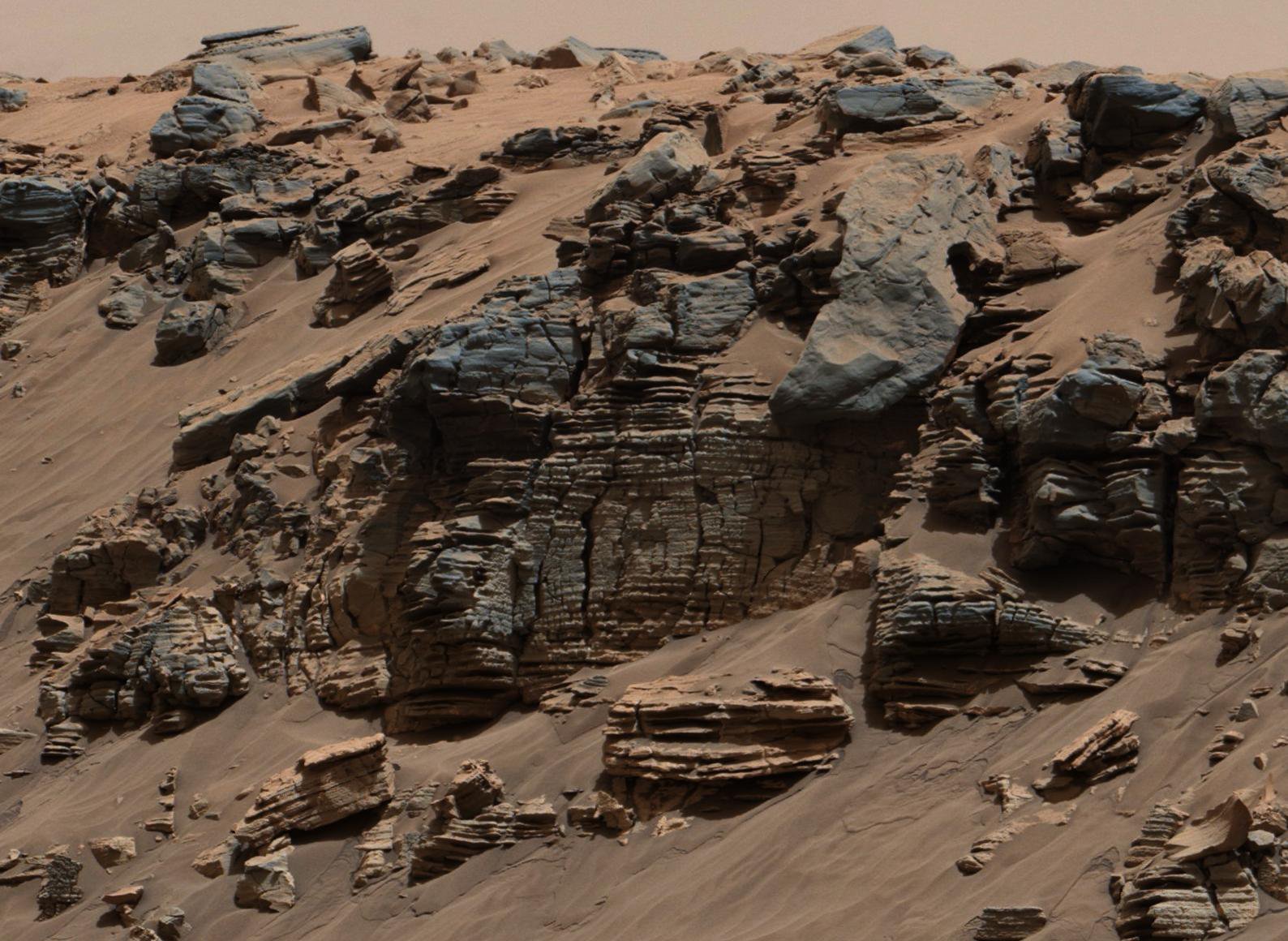
The Magnetism of Mars Gives Clues to the Planet's Interior and More
The discovery of large areas of magnetic materials on Mars indicates that the planet once had a magnetic field, much as Earth does today. Because magnetic fields in general shield planets from many forms of cosmic radiation, this discovery has important implications for the prospects for finding evidence of past life on the Martian surface. Study of the ancient magnetic field also provides important information about Mars' past interior structure, temperature, and composition. The presence of magnetic fields also suggests that Mars was once more of a dynamic Earth-like planet than it is today.
Rocks on Mars Can Tell Us About the Planet's History and Its Potential for Harboring Life
Of fundamental importance are the age and composition of different types of rocks on the Martian surface. Geologists use the age of rocks to determine the sequence of events in a planet's history. Information about rock composition tells them what happened over time. Particularly important is identifying rocks and minerals formed in the presence of water. With an ongoing series of Mars orbiters, landers, and rovers, with increasingly sophisticated tools, we are helping to answer numerous questions, such as what other materials might be trapped in rock with information about Mars' history, and how different rock types are distributed on the surface.
Seeking Signs of Life in Ancient Martian Rocks
NASA’s Perseverance Mars rover is caching rock samples for a future mission to collect and return to Earth. For Mars 2020 Deputy Project Scientist at NASA-JPL Katie Stack Morgan, studying rocks is not only important in the search for ancient life, but it’s also a hobby Credits: NASA 360
Prepare for Human Exploration
Studies are underway to determine how humans might safely journey to Mars and back to Earth. This extremely difficult engineering challenge requires a thorough understanding of the Martian environment, which is critical to the safe operation of equipment and the health of humans.
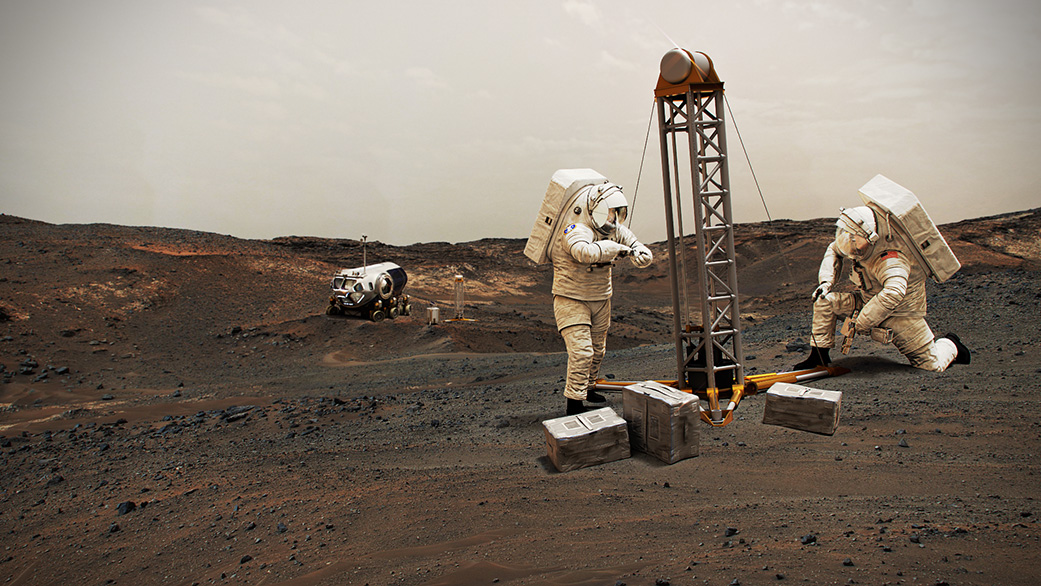
Astronaut Safety in the Harsh Martian Environment
The safety of astronauts is of paramount importance to NASA. Mars lacks an ozone layer, which on Earth shields us from lethal doses of solar ultraviolet radiation. We are seeking to expand our information about how much ultraviolet radiation reaches the Martian surface. We need a more detailed understanding of the radiation environment to assess ultraviolet effects on astronauts and help engineers design protective space suits and habitats. In the presence of UV radiation, "superoxides" in Martian soil break down organic molecules. This would probably not affect astronauts seriously, but the impact of this and any other unique chemical aspects of the Martian soil must be assessed before human exploration of Mars can begin. NASA missions have already begun to analyze the Mars radiation environment on Mars and search for water resources that could support future human explorers. Those resources could be accessed eventually by robotic spacecraft, rovers, and drills. In addition, advanced entry, descent, and landing techniques that reduce the G-forces on landers are planned for spacecraft and astronaut safety.
Much of the necessary scientific and technological work for the goal of sending humans to Mars is carried out by NASA's Johnson Space Center. For more information about eventual human Mars missions, visit NASA's Human to Mars webpage.
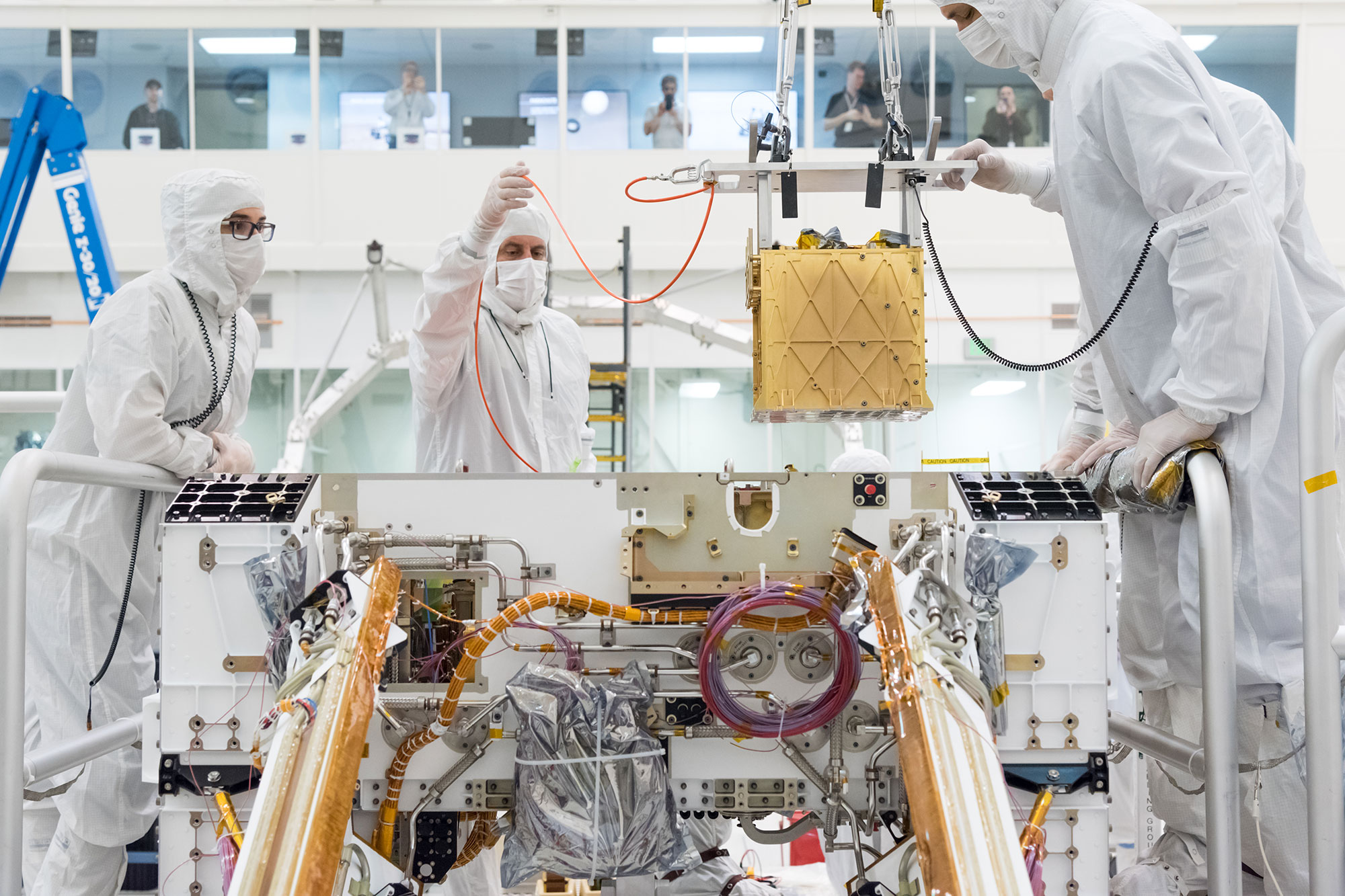
Discover More Topics From NASA
Solar System Exploration

Asteroids, Comets & Meteors


Suggested Searches
- Climate Change
- Expedition 64
- Mars perseverance
- SpaceX Crew-2
- International Space Station
- View All Topics A-Z
Humans in Space
Earth & climate, the solar system, the universe, aeronautics, learning resources, news & events.

NASA Wins 6 Webby Awards, 8 Webby People’s Voice Awards

NASA’s CloudSat Ends Mission Peering Into the Heart of Clouds

Hubble Celebrates 34th Anniversary with a Look at the Little Dumbbell Nebula
- Search All NASA Missions
- A to Z List of Missions
- Upcoming Launches and Landings
- Spaceships and Rockets
- Communicating with Missions
- James Webb Space Telescope
- Hubble Space Telescope
- Why Go to Space
- Astronauts Home
- Commercial Space
- Destinations
- Living in Space
- Explore Earth Science
- Earth, Our Planet
- Earth Science in Action
- Earth Multimedia
- Earth Science Researchers
- Pluto & Dwarf Planets
- Asteroids, Comets & Meteors
- The Kuiper Belt
- The Oort Cloud
- Skywatching
- The Search for Life in the Universe
- Black Holes
- The Big Bang
- Dark Energy & Dark Matter
- Earth Science
- Planetary Science
- Astrophysics & Space Science
- The Sun & Heliophysics
- Biological & Physical Sciences
- Lunar Science
- Citizen Science
- Astromaterials
- Aeronautics Research
- Human Space Travel Research
- Science in the Air
- NASA Aircraft
- Flight Innovation
- Supersonic Flight
- Air Traffic Solutions
- Green Aviation Tech
- Drones & You
- Technology Transfer & Spinoffs
- Space Travel Technology
- Technology Living in Space
- Manufacturing and Materials
- Science Instruments
- For Kids and Students
- For Educators
- For Colleges and Universities
- For Professionals
- Science for Everyone
- Requests for Exhibits, Artifacts, or Speakers
- STEM Engagement at NASA
- NASA's Impacts
- Centers and Facilities
- Directorates
- Organizations
- People of NASA
- Internships
- Our History
- Doing Business with NASA
- Get Involved
- Aeronáutica
- Ciencias Terrestres
- Sistema Solar
- All NASA News
- Video Series on NASA+
- Newsletters
- Social Media
- Media Resources
- Upcoming Launches & Landings
- Virtual Events
- Sounds and Ringtones
- Interactives
- STEM Multimedia

NASA’s Optical Comms Demo Transmits Data Over 140 Million Miles

Sols 4166-4167: A Garden Full of Rocks

European Service Module

NASA Shares Lessons of Human Systems Integration with Industry

Work Underway on Large Cargo Landers for NASA’s Artemis Moon Missions

NASA Open Science Initiative Expands OpenET Across Amazon Basin

Amendment 11: Physical Oceanography not solicited in ROSES-2024

NASA Data Helps Beavers Build Back Streams

Sols 4164-4165: What’s Around the Ridge-bend?

Sols 4161-4163: Double Contact Science

NASA’s Chandra Releases Doubleheader of Blockbuster Hits

Explore the Universe with the First E-Book from NASA’s Fermi

Dr. Douglas Hudgins

NASA Photographer Honored for Thrilling Inverted In-Flight Image

NASA’s Ingenuity Mars Helicopter Team Says Goodbye … for Now

NASA Langley Team to Study Weather During Eclipse Using Uncrewed Vehicles

NASA’s Near Space Network Enables PACE Climate Mission to ‘Phone Home’

Amendment 10: B.9 Heliophysics Low-Cost Access to Space Final Text and Proposal Due Date.

Washington State High Schooler Wins 2024 NASA Student Art Contest

NASA STEM Artemis Moon Trees

NASA Glenn Joins Big Hoopla STEM Challenge

First NASA Mars Analog Crew Nears End of Mission

Diez maneras en que los estudiantes pueden prepararse para ser astronautas

Astronauta de la NASA Marcos Berríos

Resultados científicos revolucionarios en la estación espacial de 2023
What is mars (grades k-4), nasa stem team, what is mars like, what has nasa learned about mars, how is nasa exploring mars today, how will nasa explore mars in the future, more about mars.
This article is for students grades K-4.
Mars is a planet. It is the fourth planet from the Sun. It is the next planet beyond Earth. Mars is more than 142 million miles from the Sun. The planet is about half the size of Earth. A day on Mars is 24.6 hours. A year on Mars is 687 Earth days. Mars is known as the Red Planet. It is red because the soil looks like rusty iron. Mars has two small moons. Their names are Phobos (FOE-bohs) and Deimos (DEE-mohs).
Mars is very cold. The average temperature on Mars is minus 80 degrees Fahrenheit — way below freezing!
Mars is rocky with canyons, volcanoes and craters all over it. Red dust covers almost all of Mars. It has clouds and wind, just as Earth does. Sometimes the wind blows the red dust into a dust storm. Tiny dust storms can look like tornados, and large ones can cover the whole planet! Mars has about one-third the gravity of Earth. A rock dropped on Mars would fall slower than a rock dropped on Earth. Things weigh less on Mars than they weigh on Earth. A person who weighs 100 pounds on Earth would only weigh about 38 pounds on Mars because of less gravity.
The air around Mars does not have much oxygen. People need oxygen to breathe. The air is mostly a gas called carbon dioxide.
NASA has used both orbiting spacecraft (spacecraft that fly around the planet) and robots on the ground to learn more about Mars. In 1965, Mariner 4 was the first NASA spacecraft to get a close look at the planet. In 1976, Viking 1 and Viking 2 were the first NASA spacecraft to land on Mars. They took pictures and explored the ground. Since then, more spacecraft have flown near or landed on Mars.
NASA’s Spirit and Opportunity rovers landed on Mars in January 2004. They found proof that water once flowed on Mars. Living things need water to survive. So, any sign of water on Mars would mean that there could be, or could have been, life on the planet.
Today, three NASA spacecraft are circling, or orbiting Mars. The spacecraft are using scientific tools to measure the volcanoes, canyons, craters, temperature and the kinds of minerals on Mars. They also are taking pictures and searching for water.
A robot that moves around the planet, called a rover, is exploring the Red Planet’s land. The rover is named Curiosity. The rover travels around taking pictures and looking closely at the planet’s soil and rocks. A robot that stays in one place is called a lander. The InSight lander is measuring earthquakes on Mars, called marsquakes. NASA uses pictures and information from the spacecraft, rover and lander to learn more about Mars.
NASA wants to send people to explore the Red Planet. But first, the space agency will send more robots. The Perseverance rover carried a small helicopter. They landed on Mars on Feb. 18, 2021. One of the rover’s jobs will be to collect rocks and soil. NASA plans to bring the rocks and soil back to Earth on a future mission. This will be the first time a mission will bring something home from Mars. The small helicopter is named Ingenuity. The helicopter will disconnect from the rover and see if it can fly by itself on Mars. If it works, NASA could build other helicopters like it to help explore Mars or other planets.
A rover and a small helicopter are studying Mars.
NASA is studying new kinds of homes where astronauts could live in space. Scientists are studying how people in space could grow plants for food. By watching what happens to astronauts on the International Space Station, scientists are finding out how living in space affects humans. All of these studies and experiments are helping NASA get ready to send people to Mars.
NASA Space Place: All About Mars NASA Space Place: The Mars Rovers Color the Mars Rover and Helicopter Make a Mars Helicopter Model Mars Activities for Kids Make a Paper Mars Helicopter Explore Mars: A Mars Rover Game
Read What Is Mars? (Grades 5-8)

IMAGES
VIDEO
COMMENTS
Mars Facts. Mars - the fourth planet from the Sun - is a dusty, cold, desert world with a very thin atmosphere. ... From this distance, it takes sunlight 13 minutes to travel from the Sun to Mars. Orbit and Rotation. As Mars orbits the Sun, it completes one rotation every 24.6 hours, which is very similar to one day on Earth (23.9 hours). ...
3) Mars is the second smallest planet in the solar system after Mercury. With a diameter (distance through the middle) of 6,791 kilometres, it's roughly half the size of Earth. 4) It can get pretty cold on Mars -- much colder than our own planet, since it's further away from the sun. At the equator, temperatures can reach 20°C, but at ...
Like the Moon, Mars is a rich destination for scientific discovery and a driver of technologies that will enable humans to travel and explore far from Earth. Mars remains our horizon goal for human exploration because it is one of the only other places we know in the solar system where life may have existed.
From this distance, it takes sunlight 13 minutes to travel from the Sun to Mars. Orbit and Rotation. Orbit and Rotation. As Mars orbits the Sun, it completes one rotation every 24.6 hours, which is very similar to one day on Earth (23.9 hours). Martian days are called sols - short for "solar day." A year on Mars lasts 669.6 sols, which is the ...
Overview. Mars is the fourth planet from the Sun - a dusty, cold, desert world with a very thin atmosphere. Mars is also a dynamic planet with seasons, polar ice caps, canyons, extinct volcanoes, and evidence that it was even more active in the past. Mars is one of the most explored bodies in our solar system, and it's the only planet where ...
NASA's Perseverance Mars rover captured this video of the Ingenuity Mars Helicopter's 54th flight on Aug. 3, 2023. After performing a preflight "wiggle check" with its rotors, the helicopter takes off, hovers at an altitude of 16 feet (5 meters), and rotates to the left, before touching back down. Credits: NASA/JPL-Caltech/ASU/MSSS.
Once every 26 months, Earth and Mars are aligned in a way that minimizes travel times and expense, enabling spacecraft to make the interplanetary journey in roughly half a year. Earth's space ...
MARS; Average Distance from Sun: 93 million miles: 142 million miles: Average Speed in Orbiting Sun: 18.5 miles per second: 14.5 miles per second: Diameter: 7,926 miles: 4,220 miles: Tilt of Axis: 23.5 degrees: 25 degrees: Length of Year: 365.25 Days: 687 Earth Days: Length of Day: 23 hours 56 minutes: 24 hours 37 minutes: Gravity: 2.66 times ...
NASA's Perseverance rover completes its journey to Mars on Feb. 18, 2021. To reach the surface of the Red Planet, it has to survive the harrowing final phase known as Entry, Descent, and Landing. Credits: NASA/JPL-Caltech. More than 3.5 billion years ago, a river there flowed into a body of water about the size of Lake Tahoe, depositing ...
Mars is a cold desert world. The average temperature on Mars is minus 85 degrees Fahrenheit - way below freezing. It is half the size of Earth. Mars is sometimes called the Red Planet. It's red because of rusty iron in the ground. Like Earth, Mars has seasons, polar ice caps, volcanoes, canyons, and weather. It has a very thin atmosphere made ...
inclination of equator to orbit. 25.2°. mean surface temperature. 210 K (−82 °F, −63 °C) typical surface pressure. 0.006 bar. number of known moons. 2. In recent times Mars has intrigued people for more-substantial reasons than its baleful appearance.
Mars is the fourth planet from the Sun.The surface of Mars is orange-red because it is covered in iron(III) oxide dust, giving it the nickname "the Red Planet". Mars is among the brightest objects in Earth's sky and its high-contrast albedo features have made it a common subject for telescope viewing. It is classified as a terrestrial planet and is the second smallest of the Solar System's ...
The Length of a Year on Mars. For any planet, a year is the time it takes to make one orbit around the Sun. Because Mars is farther away from the Sun than Earth is, it has to travel a greater distance around the Sun. It takes Mars about twice as long as it does for Earth to make one circle around the Sun. Therefore, a year on Mars lasts twice ...
5. Perseverance is the first leg of a round trip to Mars. Verifying ancient microscopic life on Mars carries an enormous burden of proof. Perseverance is the first rover to bring a sample-gathering system to Mars that will package promising examples of rocks and sediments for return to Earth by a future mission.
One day on Mars lasts about 37 minutes longer than an Earth day. A year on Mars is almost twice as long as a year on Earth. Gravity on Mars is about one-third of the gravity on Earth. If you weigh 100 pounds on Earth, you would weigh 38 pounds on Mars. Mars has two moons: Phobos and Deimos.
With a radius of 2,106 miles, Mars is the seventh largest planet in our solar system and about half the diameter of Earth. Its surface gravity is 37.5 percent of Earth's. 3:27. Mars rotates on ...
Four years after its harrowing descent through Mars's thin atmosphere, Curiosity celebrates its action-packed journey. Four Earth-years ago today, NASA's Curiosity rover successfully touched ...
All About Mars The National Aeronautics and Space Administration NASA explores the unknown in air and space, innovates for the benefit of humanity, and inspires the world through discovery.
The Red Planet is rocky, much like Earth. It has a diameter of roughly 4,222 miles (6,794 kilometers) — about half of Earth's diameter, according to the European Space Agency ( ESA ). Mars ...
This site has facts, figures, images and links about Mars.
How does Mars compare to Earth in terms of size, mass, volume, density, distance, speed, year, day, and seasons? Find out in this infographic from NASA Mars Exploration, which you can download as a PDF. Learn more about the Red Planet and its exploration missions.
Fun facts about Mars. Mars can boast the largest volcano in the entire Solar System - Olympus Mons. With a height of 21 km, it stands about 2.5 times taller than Mount Everest. Mars' larger moon, Phobos, gradually gets closer to the planet at a rate of about 2 cm per year.
The key to understanding the past, present or future potential for life on Mars can be found in NASA's four broad, overarching goals for Mars Exploration. This animated artist's concept depicts a scene of water breaking through the rim of Mars' Jezero Crater, which NASA's Perseverance rover is now exploring. Water entered the crater ...
This article is for students grades K-4. Mars is a planet. It is the fourth planet from the Sun. It is the next planet beyond Earth. Mars is more than 142 million miles from the Sun. The planet is about half the size of Earth. A day on Mars is 24.6 hours. A year on Mars is 687 Earth days. Mars is known as the Red Planet.